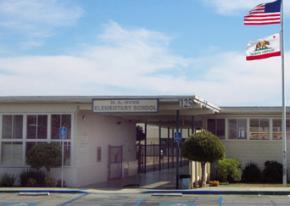Where’s our rainy day fund?
looks at the conditions students and teachers are having to endure after a Watsonville, Calif., elementary school sustained water damage.
OVER THE Martin Luther King holiday weekend, Central California experienced a series of five storms that topped the average annual rainfall by 125 percent in some areas. News coverage of the storm was extensive on every angle--from the inconvenience to commuters to the mudslides and lost pets.
What was missing from the reports was the massive damage at H.A. Hyde Elementary School in Watsonville, Calif.
Students and teachers came to school on Tuesday morning to find that their classrooms had been completely flooded. A portion of the roof had blown off, leaving parts of the building exposed for hours to the massive rainstorm. Books, computers, desks and other supplies were destroyed, and rainwater seeped into the walls and flooring. As if this wasn't enough, LCD projectors and other expensive materials were stolen a few weeks before the storm.
Teachers were told that the show must go on. The principal expected that teachers and students should carry on with the curriculum by sharing the remaining two classrooms.

Let's take a minute to visualize this situation: One hundred and twenty 6-year-olds inside three classrooms that are roughly 30 feet by 30 feet. Teachers have had to figure out how to utilize the library and any other open space in the school.
One teacher explained that last year, the staff fought hard to keep the school's librarian so that the entire school would be able to enjoy the library. Now that there are two classes taking place in the library, not a single student in the entire school is able to use services provided in the library.
The principal has said that the plan is to repair the roof and vacuum out the water from the classrooms. This process will take a few weeks and doesn't guarantee that the rooms will be free of any mold that grew over that time, making them unsafe for students and staff.
Teachers have said that the quickest and easiest solution would be to bring in four temporary buildings and allow time for teachers to set up the new classrooms.
The irony is that the school district says that this would be too expensive to do in a timely fashion--potentially forcing the district to tap into its emergency "rainy day" fund. (A quick search on the Internet by this writer found two companies able to deliver a temporary structure within a week--one said they could do it next day.)
H.A. HYDE is one of the poorest and most-segregated schools in the Pajaro School District. With 95 percent of the school population Latino, and 79 percent of the students on the free lunch program and another 10 percent on the reduced-cost lunch program, one must ask if racism plays a role in the poor response from the district and the under-reporting from the press.
It isn't like the local economy has no breadwinners. Pajaro Valley alone produces $200 million in strawberries, apples, fresh flowers, lettuce and bush berries for the rest of the United States. The Pajaro Valley Chamber of Commerce prides itself on the fact that the valley is the fifth-biggest producer of fruits and vegetables in the state. Certainly, companies like Coastal Berry and Driscoll have the ability to foot the bill.
Despite the dire straits that many families in the community are in, they were still able to raise more than $700 to send relief to the victims of Haiti's devastating earthquake. (If only the Pajaro School District had the same sense of the "human community" as H.A. Hyde parents and staff!)
Last year, the state came in to "evaluate" H.A. Hyde and train teachers on how to improve test scores and close the "achievement gap" (the idea that students of color score well below their white peers). The state spends millions of dollars every year to demean and blame teachers for the plight of under-performing schools.
This money would be better spent providing services for students and parents, and retrofitting school structures. Little did the state bureaucrats who were walking around H.A. Hyde, nit-picking each poster on the walls and the strategies used by teachers, know that the very ceiling above them could come crashing down with a serious rainstorm.
The state just may get a storm of a different sort on March 4, when parents, students, teachers and other education workers across the state participate in the day of action in defense of public education.


